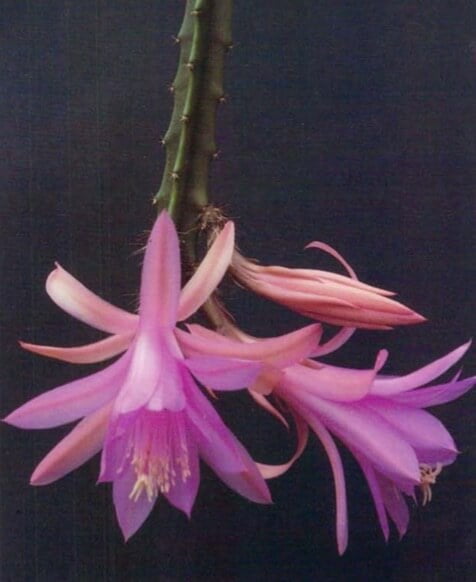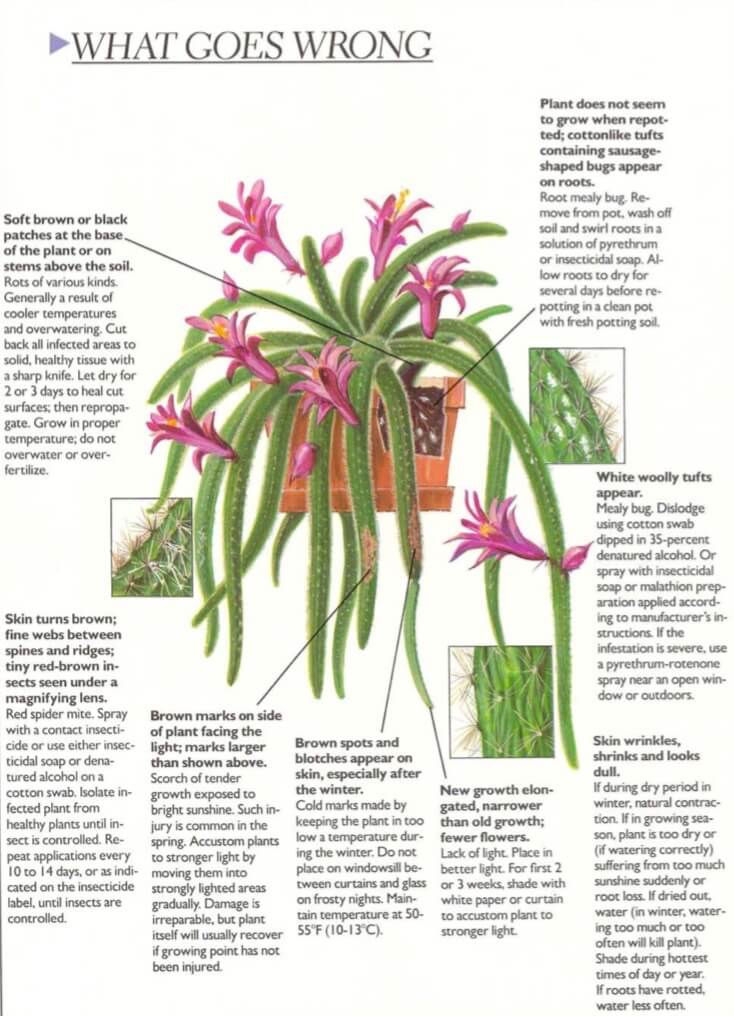[Ebook Việt Hoá] The Instant Guide to Healthy Houseplants (Hướng dẫn tức thời để chăm cây trong nhà khoẻ mạnh), Chi Disocactus
[Ebook Việt Hoá] The Instant Guide to Healthy Houseplants: Aporocactus (Rat’s tail cactus)
- Nguồn: [Ebook Việt Hoá] The Instant Guide to Healthy Houseplants (Hướng dẫn tức thời để chăm cây trong nhà khoẻ mạnh)
- Biên tập: Dũng Cá Xinh
- Biên dịch: Team Codai.net
English
There are some half-dozen species of this genus of hanging cactus. The most common of these, Aprorocactus flagelliformis, has been grown on windowsills for many years. It produces flowers all along its stems in early spring and is popularly known as the rat’s tail cactus from the form of its limp,
hanging stems. Of the other species, A. flagriformis and A. conzzatti are the most likely to be seen. There are also some very attractive flowering hybrids – crosses between Aprorocactus species and Epiphyllums (known as aporophyllums) – and other related large-flowered species that have flowers ranging from pure pink to deep reel. These make springy-stemmed, semi-pendant, freely flowering plants that are also very suitable for hanging baskets.

Light
Grows best when on a sunny windowsill indoors or when hung from the upper part of the window frame, so that its stems can hang in the light. If grown in a greenhouse, shade lightly in summer, as strong sun through glass may scorch the stems.
Temperature
Minimum during the winter, 40-50°F (4-10°C); maximum during the summer (when plant needs fresh air continually), 100°F (38°C).
Repotting
Repot each spring into pot next size larger until in 6-in (15-cm) pot. After this, repot in same-sized container each year with fresh potting soil after shaking off as much of the old soil as possible. After repotting, leave dry for 2 weeks.
Feeding
Feed once a month in spring and summer with a low-nitrogen fertilizer (5-10-10).
Soil
Use soilless mix with no grit.
Water
Water weekly in spring and summer so that soil just dries out between waterings. Water just enough in winter to stop plant from drying out completely; once every 3-4 weeks is probably enough. Mist once a week in spring and summer and once every 6-8 weeks in winter.
Cleaning and pest control
Spray with water weekly in spring and summer to keep the dust off. In winter spray about once every 6-8 weeks. Use pesticides as needed and in accordance with label directions.
Taking cuttings
- 1. After flowering is finished, cut lengths of stem 2-3 inches (5-8 cm) long with sharp knife, cutting at an angle.
- 2. Dust ends of both cutting and stem with hormone rooting powder containing fungicide. Leave cutting to dry for at least 2 days.
- 3. Prepare a 2- or 3-in (5- or 8-cm) pot with potting soil and place cutting on surface.
- 4. Cover just enough to hold it upright or rest tip against side of pot. Keep in light (not sunny) place for 2-3 weeks until roots develop. Then start watering. Repot when roots fill pot.

What Goes Wrong

- Soft brown or black patches at the of the plant or on stems above the soil: Rots of various kinds. Generally a result of cooler temperatures and overwatering. Cut back all infected areas to solid, healthy tissue with a sharp knife. Let dry for 2 or 3 days to heal cut surfaces; then repropagate. Grow in proper temperature; do not overwater or overfertilize.
- Skin turns brown; fine webs between spines and ridges; tiny red-brown insects seen under a magnifying lens: Red spider mite. Spray with a contact insecticide or use either insecticidal soap or denatured alcohol on a cotton swab. Isolate infected plant from healthy plants until insect is controlled. Repeat applications every 10 to 14 days, or as indicated on the insecticide label, until insects are controlled.
- Plant does not seem to grow when repotted; cottonlike tufts containing sausage-shaped bugs appear on roots.: Root mealy bug. Remove from pot, wash off soil and swirl roots in a solution of pyrethrum or insecticidal soap. Allow roots to dry for several days before repotting in a clean pot with fresh potting soil.
- Brown marks on side of plant facing the light; marks larger than shown above: Scorch of tender growth exposed to bright sunshine. Such injury is common in the spring. Accustom plants to stronger light by moving them into strongly lighted areas gradually. Damage is irreparable, but plant itself will usually recover if growing point has not been injured.
- Brown spots and blotches appear on skin, especially after the winter: Cold marks made by keeping the plant in too Iowa temperature during the winter. Do not place on windowsill between curtains and glass on frosty nights. Maintain temperature at 50- 55°F (10-13°C).
- New growth elongated, narrower than old growth; fewer flowers: Lack of light. Place in better light. For first 2 or 3 weeks, shade with white paper or curtain to accustom plant to stronger light.
- White woolly tufts appear: Mealy bug. Dislodge using cotton swab dipped in 35-percent denatured alcohol. Or spray with insecticidal soap or malathion preparation applied according to manufacturer’s instructions. If the infestation is severe, use E a pyrethrum-rotenone spray near an open window or outdoors.
- Skin wrinkles, shrinks and looks dull: If during dry period in winter, natural contraction. If in growing season, plant is too dry or (if watering correctly) root loss. If dried out, water (in winter, watering too much or too often will kill plant). Shade during hottest times of day or year. If roots have rotted, water less often.
Tiếng Việt
Có khoảng nửa tá loài thuộc giống xương rồng treo này. Loại phổ biến nhất trong số này, Aprorocactus flagelliformis, đã được trồng trên bệ cửa sổ trong nhiều năm. Nó ra hoa trên toàn bộ thân cây vào đầu mùa xuân và được biết đến với tên gọi phổ biến là xương rồng đuôi chuột do hình dáng của thân cây buông thõng mềm mại. Trong số các loài khác, A. flagriformis và A. conzzatti là loài phổ biến nhất. Ngoài ra còn có một số giống lai có hoa rất hấp dẫn – lai giữa các loài Aprocactus và Epiphyllums (được gọi là aporophyllums) – và các loài có hoa lớn liên quan khác.

Ánh sáng
Phát triển tốt nhất khi ở trên bệ cửa sổ đầy nắng trong nhà hoặc khi được treo ở phần trên của khung cửa sổ, để thân của nó được treo dưới ánh sáng. Nếu trồng trong nhà kính, hãy che bởi ánh nắng nhẹ vào mùa hè, vì ánh nắng mạnh xuyên qua kính có thể làm cháy xém thân cây.
Nhiệt độ
Tối thiểu trong mùa đông, 40-50 ° F (4-10 ° C); tối đa trong mùa hè (khi cây cần không khí trong lành liên tục), 100 ° F (38 ° C).
Thay chậu
Vào mùa xuân thay vào chậu có kích thước lớn hơn lên đến 6 inch (15 cm). Sau đó, thay chậu có kích thước tương tự mỗi năm bằng đất đất mới sau khi rũ bỏ càng nhiều đất cũ càng tốt. Sau khi thay chậu, để khô trong 2 tuần.
Bón phân
Bón phân mỗi tháng một lần vào mùa xuân và mùa hè với phân bón ít nitơ (5-10-10).
Đất
Sử dụng hỗn hợp không dính đất và không có sạn.
Nước
Tưới nước hàng tuần vào mùa xuân và mùa hè để đất khô đi giữa các lần tưới. Tưới nước vừa đủ vào mùa đông để cây không bị khô hoàn toàn; 3-4 tuần một lần là đủ. Phun sương mỗi tuần một lần vào mùa xuân và mùa hè và 6-8 tuần một lần vào mùa đông.
Làm sạch và kiểm soát dịch hại
Phun nước hàng tuần vào mùa xuân và mùa hè để giữ cây khỏi bụi. Vào mùa đông phun khoảng 6-8 tuần một lần. Sử dụng thuốc trừ sâu khi cần thiết và theo hướng dẫn trên nhãn.
Giâm cành
- 1. Sau khi ra hoa xong, dùng dao sắc cắt ngang thân cây dài 2-3 inch (5-8 cm), cắt theo góc nghiêng.
- 2. Phủ lên phần cuối của cả vết cắt và thân bằng bột kích tố ra rễ có chứa thuốc diệt nấm. Để vết cắt khô ít nhất 2 ngày.
- 3. Chuẩn bị một cái chậu 2 hoặc 3 inch (5 – 8 cm) với đất bầu và đặt vết cắt lên bề mặt.
- 4. Đậy vừa đủ để giữ nó thẳng đứng hoặc hơi tựa vào thành chậu. Để nơi có ánh sáng nhẹ (không nắng) trong 2-3 tuần cho đến khi rễ phát triển. Sau đó bắt đầu tưới nước. Thay chậu khi rễ đầy chậu.

Những vấn đề có thể xảy ra

- Các mảng màu nâu hoặc đen mềm ở thân cây trên mặt đất: Rễ cây nhiều loại. Nói chung là kết quả của nhiệt độ thấp và quá nhiều nước. Dùng dao sắc cắt bỏ tất cả các khu vực bị nhiễm bệnh thành mô rắn, khỏe mạnh. Để khô trong 2 hoặc 3 ngày để chữa lành các bề mặt cắt; sau đó nhân giống lại. Sinh trưởng trong nhiệt độ thích hợp; không tưới quá nhiều hoặc bón phân quá mức.
- Vỏ chuyển sang màu nâu; mạng nhện mịn giữa gai và gờ; côn trùng nhỏ màu nâu đỏ nhìn thấy dưới ống kính phóng đại: Nhện đỏ. Phun thuốc diệt côn trùng hoặc sử dụng xà phòng diệt côn trùng hoặc cồn biến tính trên tăm bông. Cách ly cây nhiễm bệnh với cây khỏe mạnh cho đến khi kiểm soát được côn trùng. Lặp lại sau 10 đến 14 ngày, hoặc theo chỉ dẫn trên nhãn thuốc diệt côn trùng, cho đến khi côn trùng được kiểm soát.
- Cây dường như không phát triển khi thay chậu; trên rễ xuất hiện các búi bông có bọ xít dài: Rệp sáp ở rễ. Lấy ra khỏi chậu, rửa sạch đất và xoáy rễ trong dung dịch cây kim châm hoặc xà phòng diệt côn trùng. Để rễ khô trong vài ngày trước khi thay vào chậu sạch có đất mới.
- Vết nâu ở mặt trên của lá, mặt tiếp xúc với ánh nắng; những vết đó lớn hơn khi ở trên cao hơn: Vết cháy khi lá mỏng bị chiếu trực tiếp với ánh nắng mặt trời mạnh. Để cây thích nghi với ánh sáng mạnh hơn bằng cách chuyển dần chúng vào khu vực có ánh sáng mạnh. Hư hại là không thể cứu, nhưng bản thân cây thường sẽ phục hồi nếu điểm phát triển không bị thương.
- Các đốm nâu xuất hiện trên vỏ, đặc biệt là sau mùa đông: Các vết đốm hình thành do giữ cây ở nhiệt độ quá thấp trong suốt mùa đông. Không đặt trên bệ cửa sổ giữa rèm và kính vào những đêm lạnh giá. Duy trì nhiệt độ ở 50-55 ° F (10-13 ° C).
- Cây mới dài, thu hẹp hơn so với cây cũ; ít hoa: Thiếu ánh sáng. Đặt ở nơi có ánh sáng tốt hơn. Trong 2 hoặc 3 tuần đầu, che nắng bằng giấy trắng hoặc rèm để cây quen với ánh sáng mạnh hơn.
- Xuất hiện các búi len màu trắng: Rệp sáp. Loại bỏ bằng tăm bông nhúng vào cồn biến tính 35%. Hoặc phun xà phòng diệt côn trùng hoặc malathion theo hướng dẫn của nhà sản xuất. Nếu sự lây nhiễm nghiêm trọng, hãy sử dụng thuốc xịt E pyrethrum-rotenone gần cửa sổ đang mở hoặc ngoài trời.
- Vỏ nhăn, co lại và trông xỉn màu: Nếu trong thời kỳ hanh khô vào mùa đông, co lại là tự nhiên. Nếu vào mùa sinh trưởng, cây quá khô hoặc (nếu tưới nước đúng cách) sẽ bị rụng rễ. Nếu khô héo thì tưới nước (vào mùa đông tưới quá nhiều hoặc quá thường xuyên sẽ làm chết cây). Che mát trong thời gian nóng nhất trong ngày hoặc trong năm. Nếu rễ đã bị thối rữa, hãy tưới ít nước hơn.



